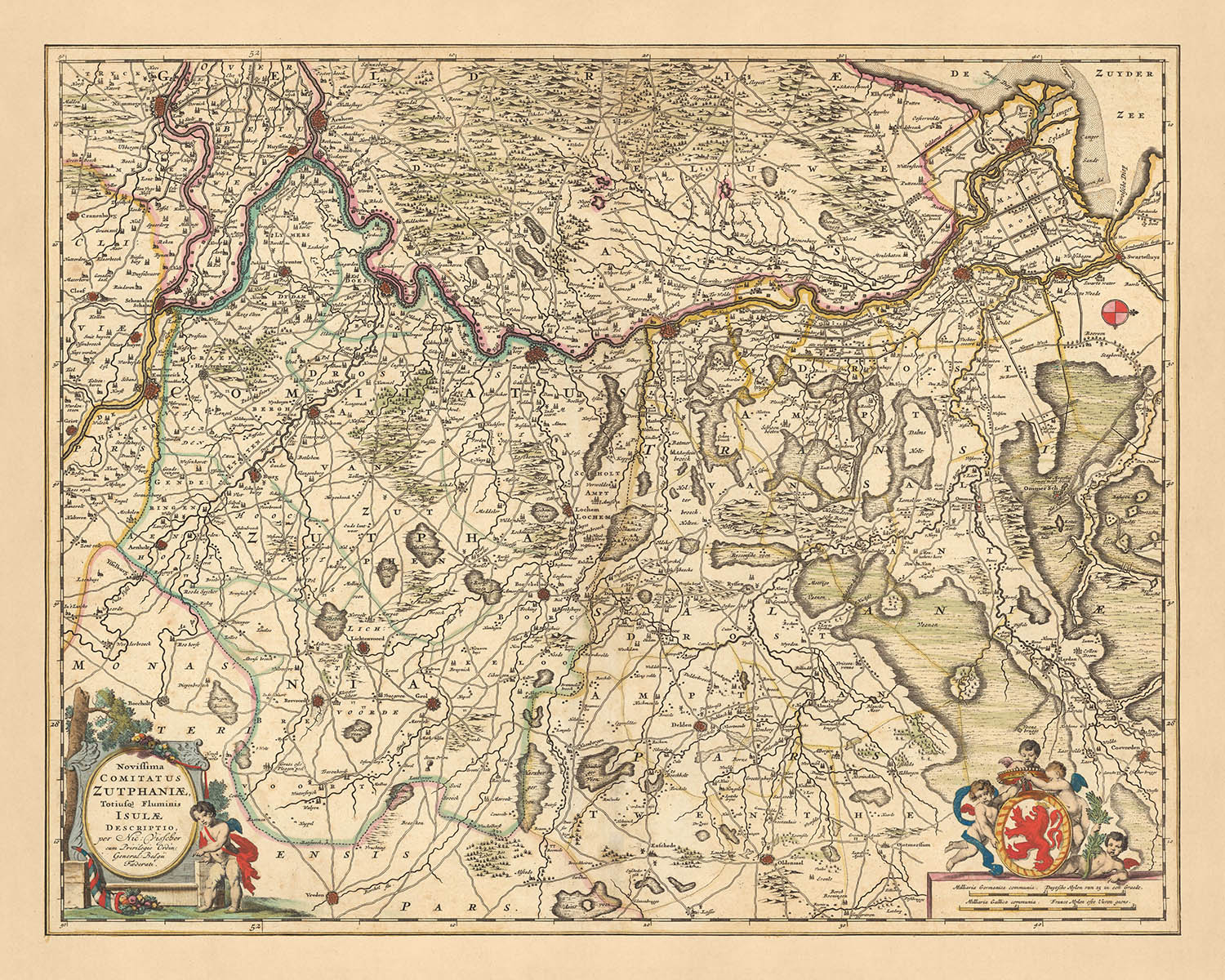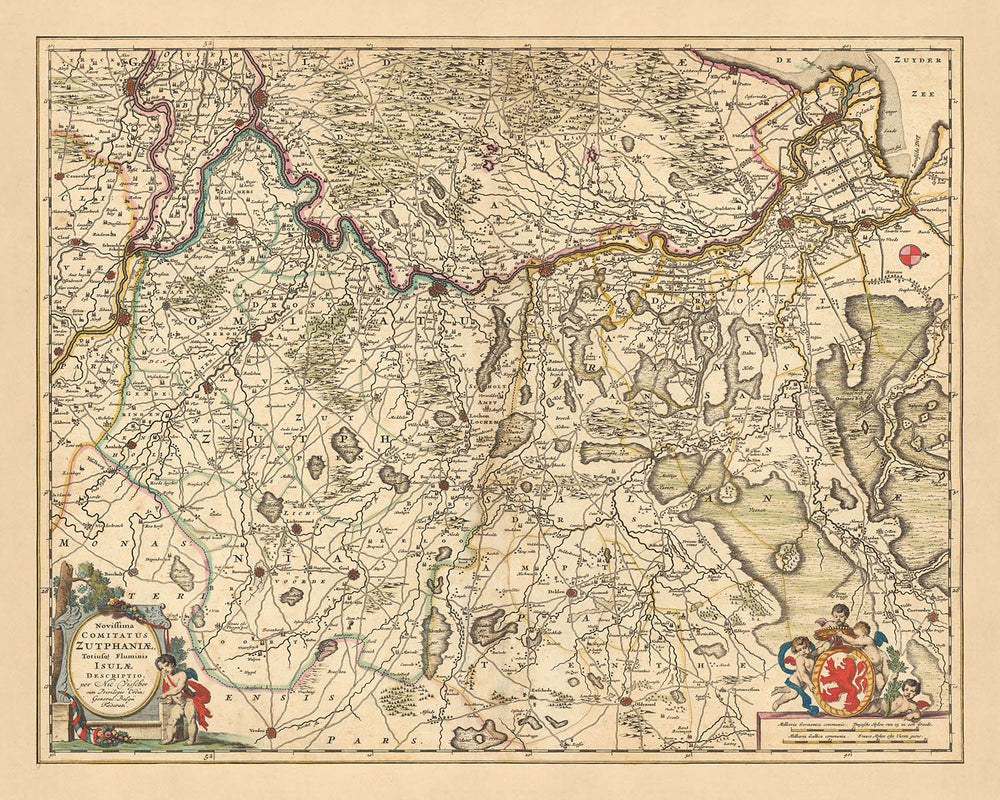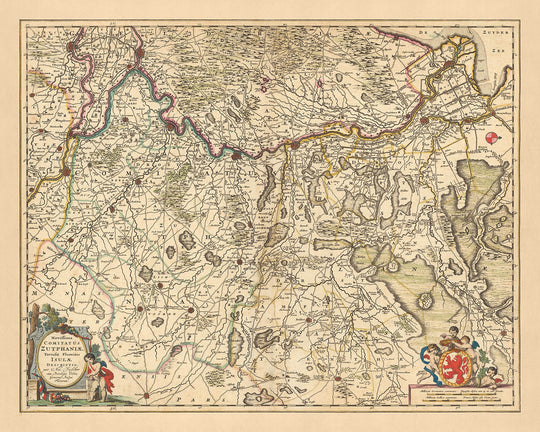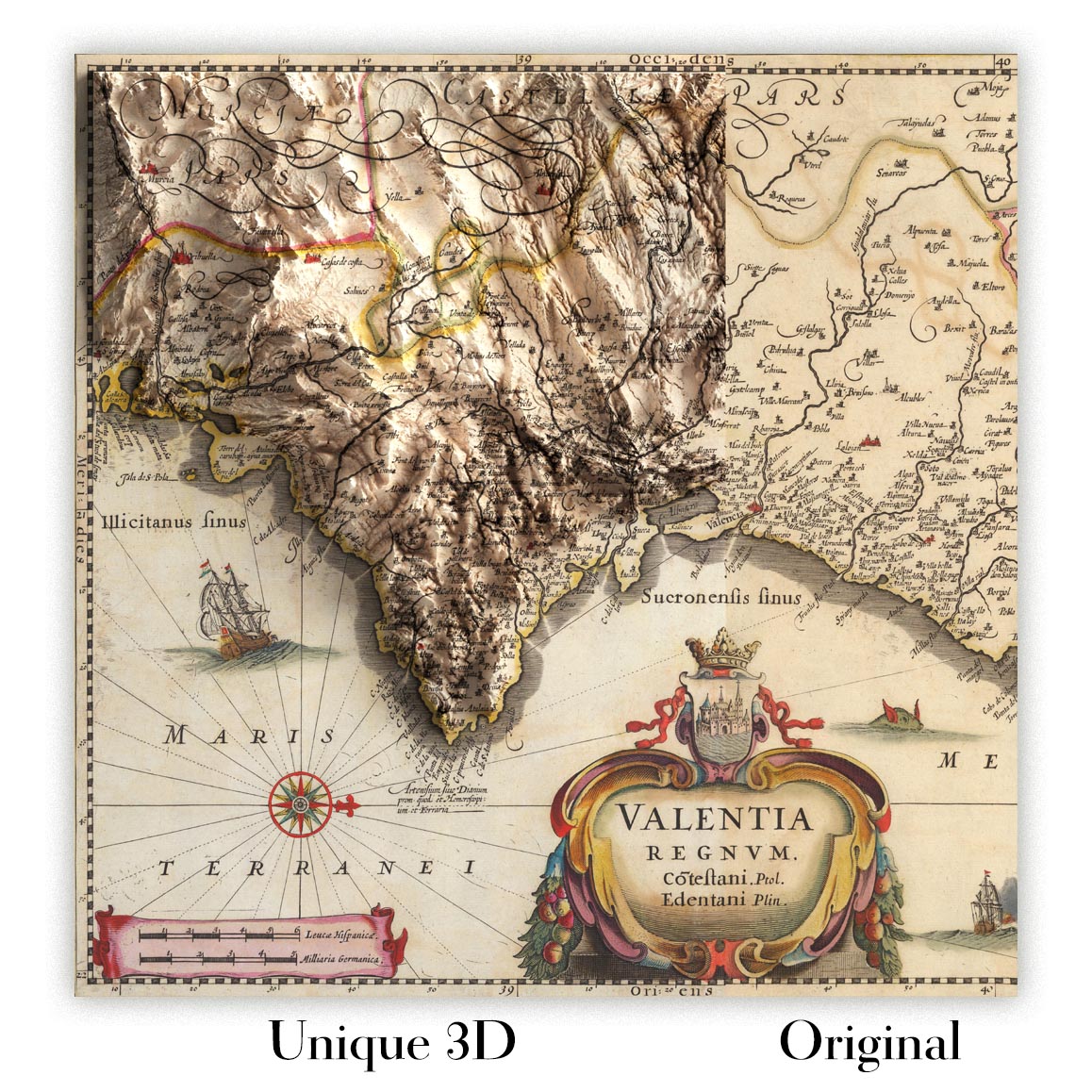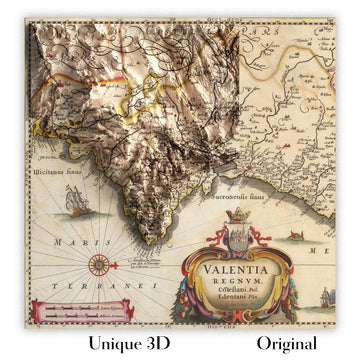- Handmade locally. No import duty or tax
- FREE worldwide delivery
- Love it or your money back (90 days)
- Questions? WhatsApp me any time
Own a piece of history
5,000+ 5 star reviews


Immerse yourself in the intricate detail of the 'Novissima comitatus Zutphaniae : totiusque fluminis isulae descriptio', a stunning map from 1690, crafted by the renowned mapmaker Nicolaes Visscher II. Translated into English, the title of this map means 'The most recent description of the county of Zutphen and the entire river island'. This map captures the historical and geographical essence of Zutphen, a region that now forms part of the modern-day Netherlands.
The map features the cities of Apeldoorn, Arnhem, Nijmegen, and Deventer, each of them rich in history and cultural significance. Apeldoorn, known for its lush parks and gardens, is beautifully represented, as is Arnhem, a city steeped in history with its origins dating back to the Middle Ages. Nijmegen, the oldest city in the Netherlands, and Deventer, one of the oldest towns in the country, are also intricately depicted, offering a glimpse into their past.
A standout feature of this map is the representation of De Hoge Veluwe National Park, one of the largest continuous nature reserves in the Netherlands. The park, known for its diverse landscapes including forests, heathlands, and sand dunes, adds a unique natural element to this historical map.
This map is not just a geographical representation but also a historical document, offering insights into the political divisions and regional boundaries of the time. The detailed depiction of the county of Zutphen and the entire river island provides a fascinating look into the Dutch Golden Age, making this map a valuable addition to any collection. Explore the historical landscape of the Netherlands through the eyes of Nicolaes Visscher II, and appreciate the artistry and precision that went into creating this beautiful map.
Some of the significant locations shown on this map:
County of Zutphen:
- Zutphen: Known as the city with one of the oldest libraries in the Netherlands, it was an important trading city in the Middle Ages.
- Apeldoorn: Notable for its royal palace, Paleis Het Loo, and its beautiful parks and gardens.
- Arnhem: Known for its historical buildings and parks, it was a significant city in the Middle Ages.
- Nijmegen: The oldest city in the Netherlands, it was known as Ulpia Noviomagus Batavorum in Roman times.
- Deventer: One of the oldest towns in the country, it was a significant center of book production in the Middle Ages.
- Doetinchem: Founded in the 11th century, it was known for its castle (Slangenburg Castle) and its strategic location.
- Harderwijk: Known for its University, which was founded in 1600.
- Ede: A historical town known for its proximity to the Hoge Veluwe National Park.
- Wageningen: Known for its University, which was founded in 1618.
- Zevenaar: An old town with a rich history dating back to Roman times.
- Elburg: A medieval fortified town in the province of Gelderland.
- Lochem: Known for its beautiful landscapes and its 11th-century church.
- Zaltbommel: Known for its well-preserved medieval city center.
- Tiel: Known as the "Fruit Capital" of the Netherlands, it was an important center of trade in the Middle Ages.
- Culemborg: Known for its historic buildings, including the 14th-century castle.
Notable Natural Phenomena:
- The Rhine River: One of the longest and most important rivers in Europe.
- The IJssel River: A branch of the Rhine in the Dutch provinces of Gelderland and Overijssel.
- The Maas River: A major European river, rising in France and flowing through Belgium and the Netherlands.
- The Hoge Veluwe National Park: One of the largest continuous nature reserves in the Netherlands.
- The Veluwe: A forest-rich ridge of hills in the province of Gelderland.
Notable Historical Events (1600-1690):
- The Eighty Years' War (1568–1648): A revolt of the Seventeen Provinces against the political and religious hegemony of Philip II of Spain.
- The Dutch Golden Age (17th century): A period in Dutch history, in which Dutch trade, science, and art were among the most acclaimed in the world.
- The Anglo-Dutch Wars (1652–1674): A series of conflicts fought between the English and the Dutch for control over the seas and trade routes.
Please double check the images to make sure that a specific town or place is shown on this map. You can also get in touch and ask us to check the map for you.
This map looks great at all sizes: 12x16in (30.5x41cm), 16x20in (40.5x51cm), 18x24in (45.5x61cm), 24x30in (61x76cm), 32x40in (81.5x102cm), 40x50in (102x127cm), 48x60in (122x153cm) and 56x70in (142x178cm), but it looks even better when printed large.
I can create beautiful, large prints of this map up to 90in (229cm). Please get in touch if you're looking for larger, customised or different framing options.
The model in the listing images is holding the 16x20in (40.5x51cm) version of this map.
The fifth listing image shows an example of my map personalisation service.
If you’re looking for something slightly different, check out my collection of the best old maps of Europe and European cities to see if something else catches your eye.
Please contact me to check if a certain location, landmark or feature is shown on this map.
This would make a wonderful birthday, Christmas, Father's Day, work leaving, anniversary or housewarming gift for someone from the areas covered by this map.
This map is available as a giclée print on acid free archival matte paper, or you can buy it framed. The frame is a nice, simple black frame that suits most aesthetics. Please get in touch if you'd like a different frame colour or material. My frames are glazed with super-clear museum-grade acrylic (perspex/acrylite), which is significantly less reflective than glass, safer, and will always arrive in perfect condition.
This map is also available as a float framed canvas, sometimes known as a shadow gap framed canvas or canvas floater. The map is printed on artist's cotton canvas and then stretched over a handmade box frame. We then "float" the canvas inside a wooden frame, which is available in a range of colours (black, dark brown, oak, antique gold and white). This is a wonderful way to present a map without glazing in front. See some examples of float framed canvas maps and explore the differences between my different finishes.
For something truly unique, this map is also available in "Unique 3D", our trademarked process that dramatically transforms the map so that it has a wonderful sense of depth. We combine the original map with detailed topography and elevation data, so that mountains and the terrain really "pop". For more info and examples of 3D maps, check my Unique 3D page.
For most orders, delivery time is about 3 working days. Personalised and customised products take longer, as I have to do the personalisation and send it to you for approval, which usually takes 1 or 2 days.
Please note that very large framed orders usually take longer to make and deliver.
If you need your order to arrive by a certain date, please contact me before you order so that we can find the best way of making sure you get your order in time.
I print and frame maps and artwork in 23 countries around the world. This means your order will be made locally, which cuts down on delivery time and ensures that it won't be damaged during delivery. You'll never pay customs or import duty, and we'll put less CO2 into the air.
All of my maps and art prints are well packaged and sent in a rugged tube if unframed, or surrounded by foam if framed.
I try to send out all orders within 1 or 2 days of receiving your order, though some products (like face masks, mugs and tote bags) can take longer to make.
If you select Express Delivery at checkout your order we will prioritise your order and send it out by 1-day courier (Fedex, DHL, UPS, Parcelforce).
Next Day delivery is also available in some countries (US, UK, Singapore, UAE) but please try to order early in the day so that we can get it sent out on time.
My standard frame is a gallery style black ash hardwood frame. It is simple and quite modern looking. My standard frame is around 20mm (0.8in) wide.
I use super-clear acrylic (perspex/acrylite) for the frame glass. It's lighter and safer than glass - and it looks better, as the reflectivity is lower.
Six standard frame colours are available for free (black, dark brown, dark grey, oak, white and antique gold). Custom framing and mounting/matting is available if you're looking for something else.
Most maps, art and illustrations are also available as a framed canvas. We use matte (not shiny) cotton canvas, stretch it over a sustainably sourced box wood frame, and then 'float' the piece within a wood frame. The end result is quite beautiful, and there's no glazing to get in the way.
All frames are provided "ready to hang", with either a string or brackets on the back. Very large frames will have heavy duty hanging plates and/or a mounting baton. If you have any questions, please get in touch.
See some examples of my framed maps and framed canvas maps.
Alternatively, I can also supply old maps and artwork on canvas, foam board, cotton rag and other materials.
If you want to frame your map or artwork yourself, please read my size guide first.
My maps are extremely high quality reproductions of original maps.
I source original, rare maps from libraries, auction houses and private collections around the world, restore them at my London workshop, and then use specialist giclée inks and printers to create beautiful maps that look even better than the original.
My maps are printed on acid-free archival matte (not glossy) paper that feels very high quality and almost like card. In technical terms the paper weight/thickness is 10mil/200gsm. It's perfect for framing.
I print with Epson ultrachrome giclée UV fade resistant pigment inks - some of the best inks you can find.
I can also make maps on canvas, cotton rag and other exotic materials.
Learn more about The Unique Maps Co.
Map personalisation
If you're looking for the perfect anniversary or housewarming gift, I can personalise your map to make it truly unique. For example, I can add a short message, or highlight an important location, or add your family's coat of arms.
The options are almost infinite. Please see my map personalisation page for some wonderful examples of what's possible.
To order a personalised map, select "personalise your map" before adding it to your basket.
Get in touch if you're looking for more complex customisations and personalisations.
Map ageing
I have been asked hundreds of times over the years by customers if they could buy a map that looks even older.
Well, now you can, by selecting Aged before you add a map to your basket.
All the product photos you see on this page show the map in its Original form. This is what the map looks like today.
If you select Aged, I will age your map by hand, using a special and unique process developed through years of studying old maps, talking to researchers to understand the chemistry of aging paper, and of course... lots of practice!
If you're unsure, stick to the Original colour of the map. If you want something a bit darker and older looking, go for Aged.
If you are not happy with your order for any reason, contact me and I'll get it fixed ASAP, free of charge. Please see my returns and refund policy for more information.
I am very confident you will like your restored map or art print. I have been doing this since 1984. I'm a 5-star Etsy seller. I have sold tens of thousands of maps and art prints and have over 5,000 real 5-star reviews. My work has been featured in interior design magazines, on the BBC, and on the walls of dozens of 5-star hotels.
I use a unique process to restore maps and artwork that is massively time consuming and labour intensive. Hunting down the original maps and illustrations can take months. I use state of the art and eye-wateringly expensive technology to scan and restore them. As a result, I guarantee my maps and art prints are a cut above the rest. I stand by my products and will always make sure you're 100% happy with what you receive.
Almost all of my maps and art prints look amazing at large sizes (200cm, 6.5ft+) and I can frame and deliver them to you as well, via special oversized courier. Contact me to discuss your specific needs.
Or try searching for something!







